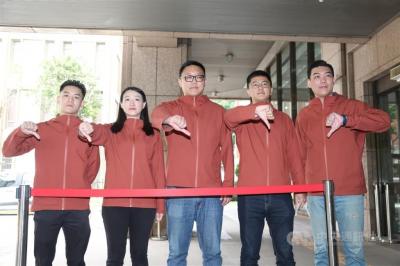The Chinese Nationalist Party (KMT) registered total assets of NT$26.8 billion (US$892.4 million), which earned the party NT$981.52 million in interest last year, about 63 percent of the party’s NT$1.549 billion in total revenue for the year, the Ministry of the Interior reported.
Pointing to the party’s vast assets and variety of profit-making enterprises under its control, critics said the KMT still retains the title of “the world’s richest political party.”
The party was described as “KMT Inc” by the Far Eastern Economic Review in 1994.
Critics further charged that much of the KMT’s assets were ill-gotten gains from past business monopolies and special privileges based on political connections over the party’s almost six decades of one-party rule in Taiwan.
Critics also said that the latest figures reveal that President Ma Ying-jeou (馬英九) has deceived the public with more “bounced checks.”
Ma promised when he assumed the KMT chairmanship in 2005 that party assets would not be used for election campaigns, and that the assets would be sold off and placed in trusts.
The ministry’s report showed that the Democratic Progressive Party (DPP) had a revenue of NT$440 million last year, less than 30 percent of the KMT’s.
The Taiwan Solidarity Union (TSU) and the People First Party (PFP) had revenues of NT$73 million and NT$39 million respectively.
Among the four major political parties, only the KMT has a spending deficit, with expenditure of NT$1.977 billion last year against revenue of NT$1.549 billion, putting it NT$428 million in the red.
The DPP had revenue of NT$440 million, with expenditure of NT$423 million last year, for a surplus of NT$17 million; the TSU had revenue of NT$73.37 million, with expenditure of NT$53.38 million, for a surplus of NT$19.99 million; and the PFP had revenue of NT$39.06 million, on expenditure of NT$11.57 million, for a NT$27.49 million surplus, according to the reports.
The KMT spent NT$1.4 billion, along with NT$500 million for office expenses, higher than the DPP’s overall party expenditure of NT$423 million last year.
The main sources of the KMT’s income are from property trusts (財產信託) of the party’s enterprises, which came to NT$981.52 million, or 63.37 percent of the party’s overall income last year.
The rest of the KMT’s income came from state subsidies (based on the party’s electoral results) at NT$293.12 million and political donations at NT$28.16 million.
The DPP’s main source of income was from state subsidies (based on party’s electoral results) at NT$227.82 million, at 51.7 percent of party’s overall income last year.
The DPP’s other income was NT$132.28 million in political donations and NT$51.66 million from party membership fees.
Instead of selling off party assets and putting the money into trusts, KMT has continue to reap profits from its investments, which contributed NT$980 million to party coffers last year. From 2006 to last year, the KMT’s investments have contributed a total of NT$13.56 billion to the party’s coffers.

Taiwan is stepping up plans to create self-sufficient supply chains for combat drones and increase foreign orders from the US to counter China’s numerical superiority, a defense official said on Saturday. Commenting on condition of anonymity, the official said the nation’s armed forces are in agreement with US Admiral Samuel Paparo’s assessment that Taiwan’s military must be prepared to turn the nation’s waters into a “hellscape” for the Chinese People’s Liberation Army (PLA). Paparo, the commander of the US Indo-Pacific Command, reiterated the concept during a Congressional hearing in Washington on Wednesday. He first coined the term in a security conference last

Prosecutors today declined to say who was questioned regarding alleged forgery on petitions to recall Democratic Progressive Party (DPP) legislators, after Chinese-language media earlier reported that members of the Chinese Nationalist Party (KMT) Youth League were brought in for questioning. The Ministry of Justice Investigation Bureau confirmed that two people had been questioned, but did not disclose any further information about the ongoing investigation. KMT Youth League members Lee Hsiao-liang (李孝亮) and Liu Szu-yin (劉思吟) — who are leading the effort to recall DPP caucus chief executive Rosalia Wu (吳思瑤) and Legislator Wu Pei-yi (吳沛憶) — both posted on Facebook saying: “I

Sung Chien-liang (宋建樑), who led efforts to recall Democratic Progressive Party (DPP) Legislator Lee Kun-cheng (李坤城), was released on bail of NT$80,000 today amid outcry over his decision to wear a Nazi armband to questioning the night before. Sung arrived at the New Taipei District Prosecutors’ Office for questioning in a recall petition forgery case last night wearing a red armband bearing a swastika, carrying a copy of Adolf Hitler’s Mein Kampf and giving a Nazi salute. Sung left the building at 1:15am without the armband and covering the book with his coat. Lee said today that this is a serious

A court has approved Kaohsiung prosecutors’ request that two people working for Democratic Progressive Party (DPP) Legislator Lin Dai-hua (林岱樺) be detained, as a probe into two cases allegedly involving her continues. The request was made on Friday, after prosecutors raided Lin’s two offices and the staffers’ residences, and questioned five on suspicion of contravening the Anti-Corruption Act (貪汙治罪條例). The people included the directors of Lin’s Daliao (大寮) and Linyuan (林園) district offices in Kaohsiung, surnamed Chou (周) and Lin (林) respectively, as well as three other staffers. The prosecutors’ move came after they interrogated Lin Dai-hua on Wednesday. She appeared solemn following